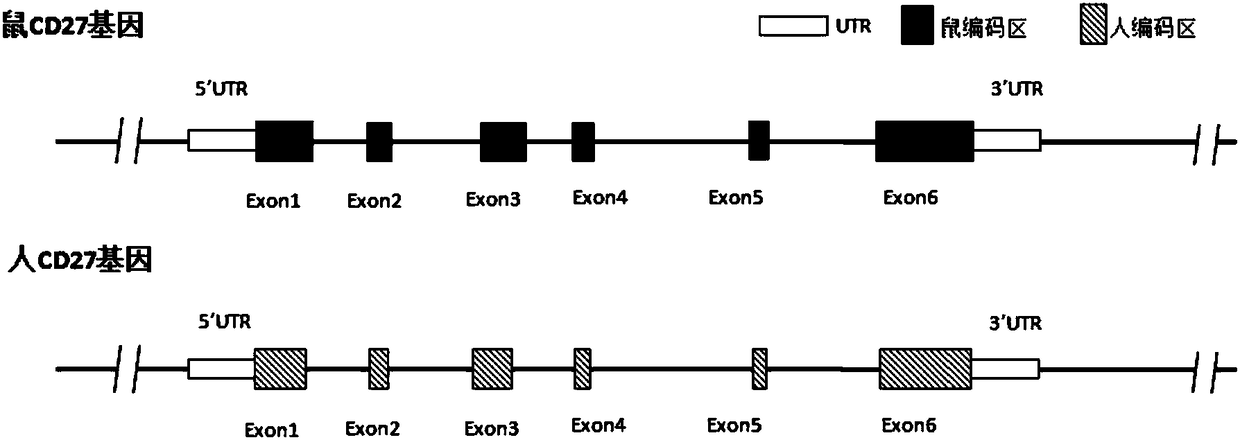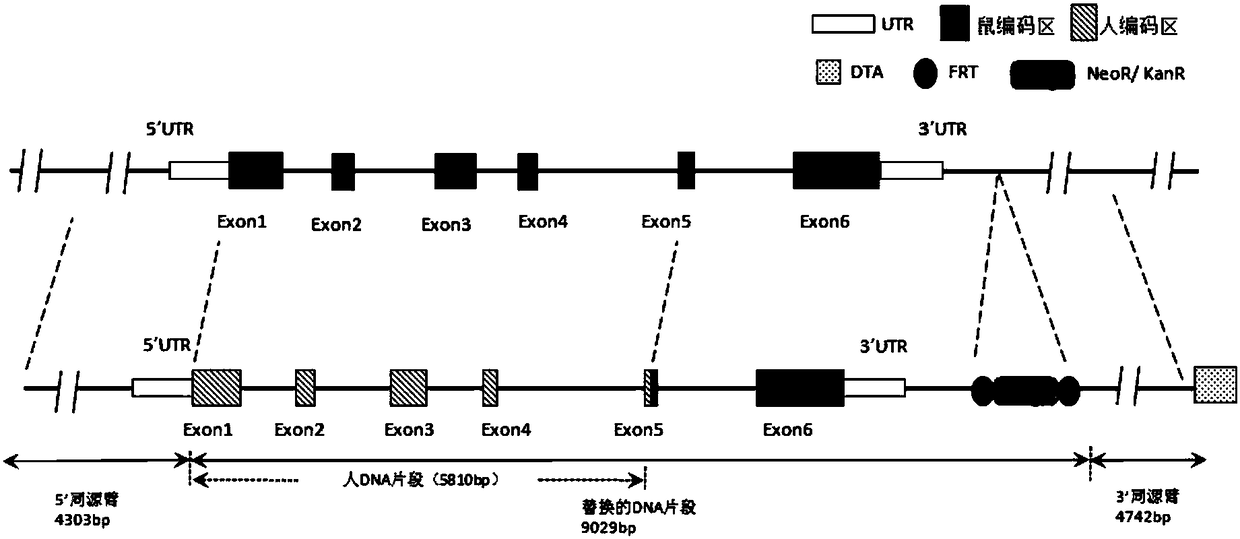Preparation method and application of humanized gene modification animal model
A humanized, non-human animal technology, applied in the fields of botanical equipment and methods, biochemical equipment and methods, plant genetic improvement, etc., can solve the problem of delayed response of memory T cells, reduce the risk of drug development, save money Time and cost, the effect of speeding up the development process
- Summary
- Abstract
- Description
- Claims
- Application Information
AI Technical Summary
Problems solved by technology
Method used
Image
Examples
Embodiment 1
[0132] Example 1 Homologous Recombination Fragment Primer Design and PCR Amplification
[0133] According to the experimental design scheme, primers for amplifying seven homologous recombination fragments (A1, A2-1, A2-2, A3, B, C1, C2) were designed. The primer sequences are shown in Table 1.
[0134] Table 1 Homologous recombination fragments and their corresponding lengths and primer sequences
[0135]
[0136]
[0137] Using BAC as a template, 7 homologous recombination fragments were amplified using KOD-plus-polymerase. Among them, A1, A3, B, C1, and C2 select the BAC containing the mouse Cd27 genome as the template, and A2-1 and A2-2 select the BAC containing the human CD27 genome as the template. The specific PCR reaction system and reaction conditions are shown in Table 2.
[0138] Table 2PCR reaction system and reaction conditions
[0139]
[0140] The product fragments A1, A2-1, A2-2, A3, B, C1, and C2 obtained by PCR amplification are recovered and direc...
Embodiment 2
[0141] Example 2 Construction of Homologous Recombination Targeting Vector
[0142] Schematic diagram of comparison between mouse Cd27 gene and human CD27 gene figure 1 shown. The inventor designed figure 2 The targeting strategy is shown and the design of the targeting vector is shown. Mouse Cd27 (based on NM_001033126.2, namely SEQ ID NO: 15, and its corresponding protein expression NP_001028298.1, namely SEQ ID NO: 16) has a total of 6 exons. The child (all or part) is replaced with a human CD27 gene (based on NM_001242.4, namely SEQ ID NO: 17, and its corresponding protein expression NP_001233.1, namely SEQ ID NO: 18), and the neo gene is added after the 3'UTR with Screening of positive clones. The length of the 5' homology arm (SEQ ID NO: 19) is 4303bp, the length of the 3' homology arm is 4742bp (SEQ ID NO: 20), and the length of the human DNA fragment is 5810bp (SEQ ID NO: 21). The final desired CDS region, mRNA sequence and encoded protein sequence of the humaniz...
Embodiment 3
[0162] Example 3 Verification of carrier pDTA-down-ABC
[0163] Randomly select 4 pDTA-down-ABC clones, and use 3 sets of enzymes to perform digestion verification. Among them, 6817p+4629bp+3682bp+2952bp+2618bp+1786bp+1035bp should appear after digestion with BamHI, and should appear after digestion with XhoI 9976bp+5502bp+4037bp+2210bp+1477bp+317bp, after digestion with EcoRI, 8679bp+6589bp+5033bp+3218bp should appear. The enzyme digestion results were all in line with expectations, see Figure 5 , indicating that all plasmid digestion verification results are correct. Among them, the plasmids numbered 1-1 and 2-1 were verified to be correct by the sequencing company.
PUM
 Login to View More
Login to View More Abstract
Description
Claims
Application Information
 Login to View More
Login to View More - R&D
- Intellectual Property
- Life Sciences
- Materials
- Tech Scout
- Unparalleled Data Quality
- Higher Quality Content
- 60% Fewer Hallucinations
Browse by: Latest US Patents, China's latest patents, Technical Efficacy Thesaurus, Application Domain, Technology Topic, Popular Technical Reports.
© 2025 PatSnap. All rights reserved.Legal|Privacy policy|Modern Slavery Act Transparency Statement|Sitemap|About US| Contact US: help@patsnap.com



